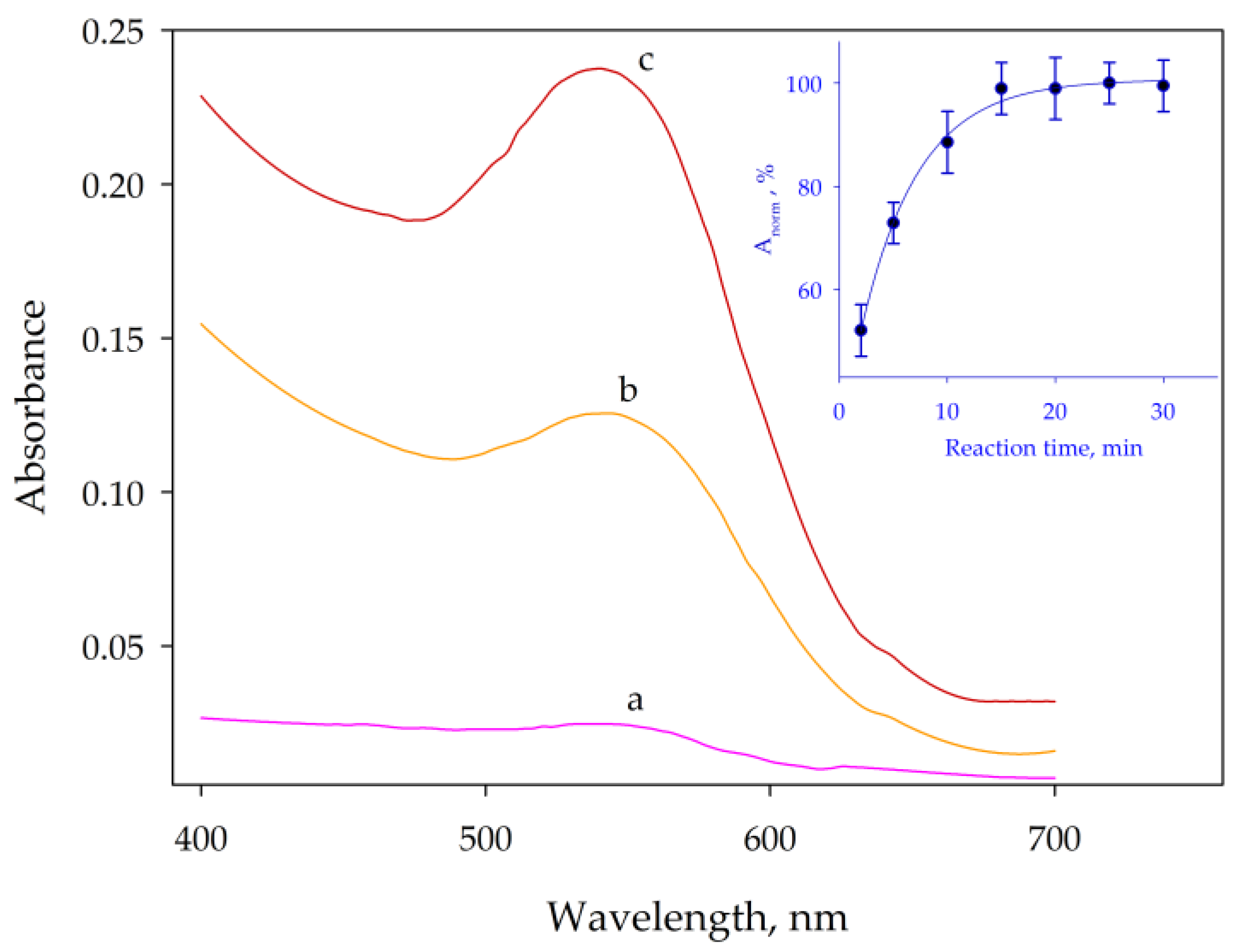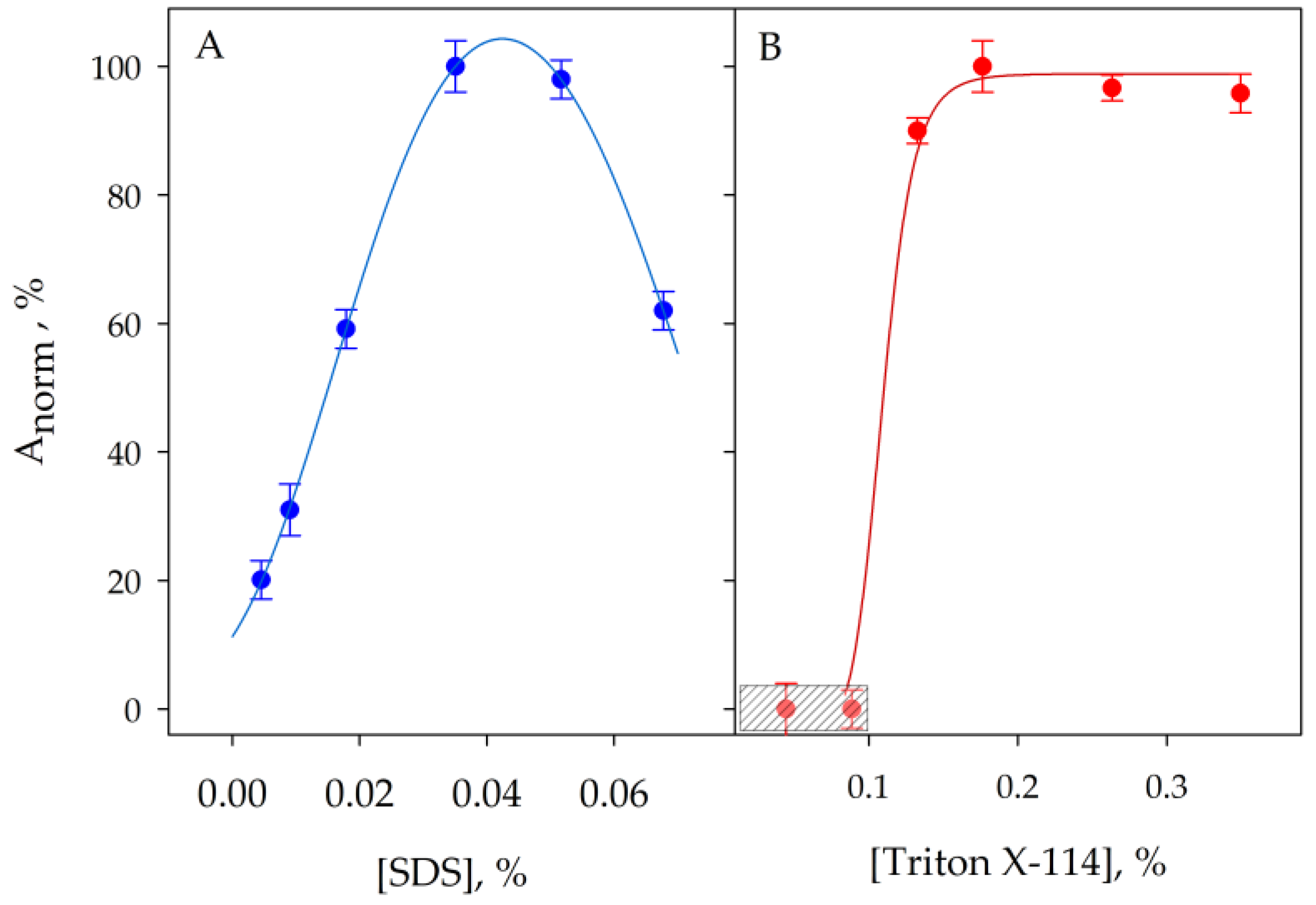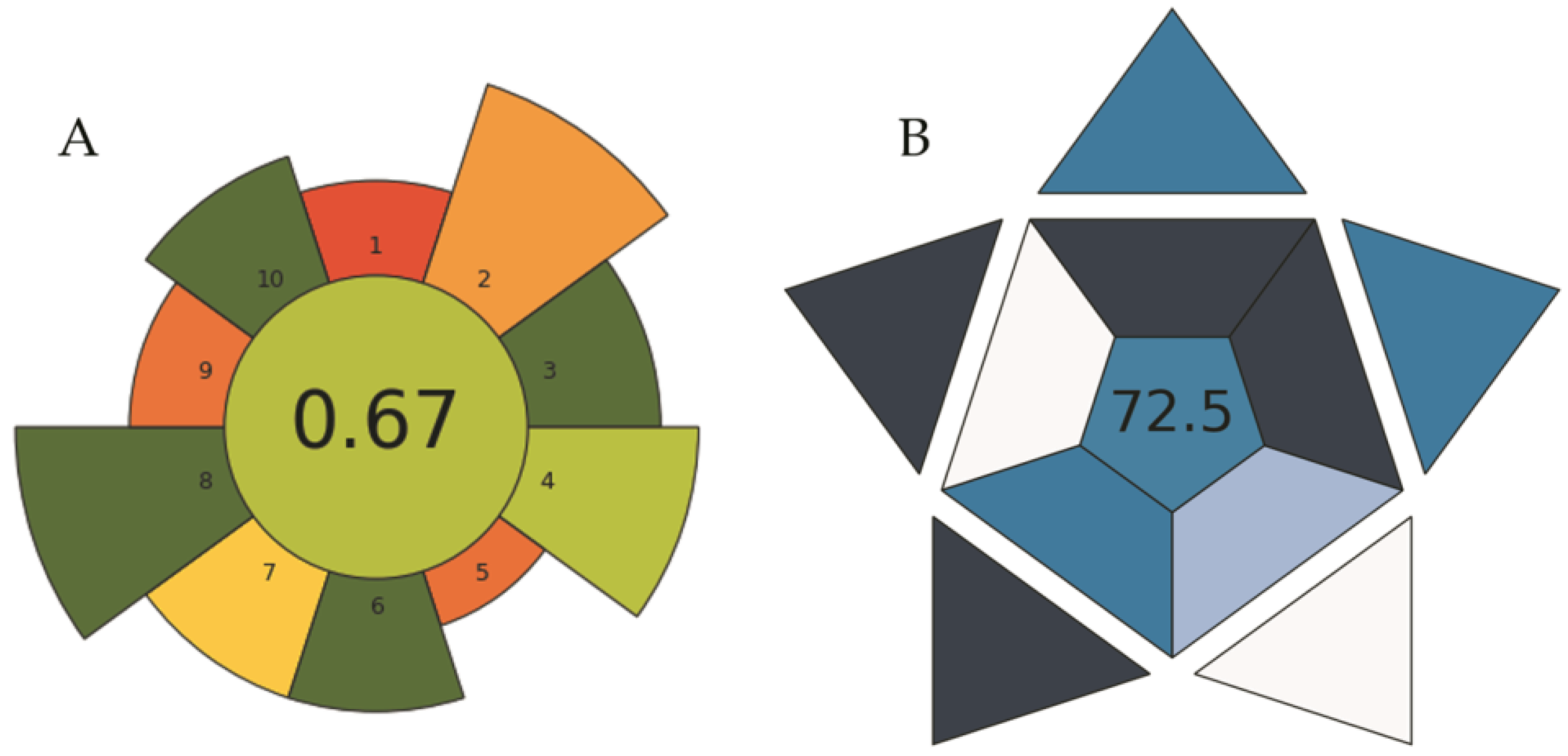Improvement in the Chromium(VI)-Diphenylcarbazide Determination Using Cloud Point Microextraction; Speciation of Chromium at Low Levels in Water Samples
Abstract
:1. Introduction
2. Results and Discussion
2.1. Optimization of the CPE Stage
2.2. Analytical Figures of Merit
2.3. Speciation Results
| Analyte | Separation | Detection | Calibration, µg L−1 | LOD, µg/L | EF | Reference |
|---|---|---|---|---|---|---|
| Cr3+, Cr6+ | SE | ETAAS | 1–10 | 0.2 | -- | [6] |
| Cr3+, Cr6+ | SM-DLLME-SFO | UV–Vis | 1–40 | 0.23 | 50 | [11] |
| Cr3+, Cr6+ | None | UV–Vis | 500–30,000; 5–300 | 300; 3 | -- | [16] |
| Cr6+ | CPE | UV–Vis; FAAS | 1.5–250; 1.85–1000 | 0.41; 0.55 | 5; 10 | [26] |
| Cr3+, Cr6+ | FIA-CER | UV–Vis | 0–2 | 70–120 pg | -- | [33] |
| Cr6+ | SPE | UV–Vis | 0–26 | 0.15 | 50 | [34] |
| Cr3+, Cr6+ | EME | ETAAS | 0.05–5 | 0.02 | 110 | [35] |
| Cr3+, Cr6+ | IP-SA-DLLME | FO-LADS | 0.2–20 | 0.05 | 159 | [36] |
| Cr6+ | SPME | UV–Vis | 1.8–60 | 0.6 | 125 | [49] |
| Cr3+, Cr6+ | UEAASLLM-SFO | ETAAS | 0.01–0.3 | 0.003 | 174 | [50] |
| Cr3+, Cr6+ | SA-DLLME–SFO | ETAAS | 0.05–0.4 | 0.004 | 40 | [51] |
| Cr3+, Cr6+ | CPE | UV–Vis | 0.04–2 | 0.02 | 415 | This work |
2.4. Application of the Proposed Procedure to Water Samples
3. Materials and Methods
3.1. Instruments
3.2. Reagents
3.3. Samples and Reference Materials
3.4. Procedures
4. Conclusions
Author Contributions
Funding
Data Availability Statement
Conflicts of Interest
References
- DesMarais, T.L.; Costa, M. Mechanisms of Chromium-Induced Toxicity. Curr. Opin. Toxicol. 2019, 14, 1–7. [Google Scholar] [CrossRef] [PubMed]
- Yan, G.; Gao, Y.; Xue, K.; Qi, Y.; Fan, Y.; Tian, X.; Wang, J.; Zhao, R.; Zhang, P.; Liu, Y.; et al. Toxicity mechanisms and remediation strategies for chromium exposure in the environment. Front. Environ. Sci. 2023, 11, 1131204. [Google Scholar] [CrossRef]
- Noroozifar, M.; Khorasani-Motlagh, M. Specific extraction of chromium as tetrabutylammonium-chromate and spectrophotometric determination by diphenylcarbazide: Speciation of chromium in effluent streams. Anal. Sci. 2003, 19, 705–708. [Google Scholar] [CrossRef] [PubMed]
- Ma, J.; Yuan, D.; Byrne, R.H. Flow injection analysis of trace chromium (VI) in drinking water with a liquid waveguide capillary cell and spectrophotometric detection. Environ. Monit. Assess. 2014, 186, 367–373. [Google Scholar] [CrossRef] [PubMed]
- Bregnbak, D.; Johansen, J.D.; Jellesen, M.S.; Zachariae, C.; Thyssen, J.P. Chromium(VI) release from leather and metals can be detected with a diphenylcarbazide spot test. Contact Derm. 2015, 73, 281–288. [Google Scholar] [CrossRef] [PubMed]
- Simonova, T.N.; Dubrovina, V.A.; Vishnikin, A.B. Speciation of chromium through aqueous two-phase extraction of complexes of Cr(III) with 4-(2-pyridylazo)resorcinol and Cr(VI) with 1,5-diphenylcarbazide. J. Serbian Chem. Soc. 2016, 81, 645–659. [Google Scholar] [CrossRef]
- Jyothi, N.; Farook, N.; Cho, M.; Shim, J. Analysis and Speciation of Chromium in Environmental Matrices by Various Analytical Techniques. Asian J. Chem. 2013, 25, 4125–4136. [Google Scholar] [CrossRef]
- József, P.; Dávid, N.; Sándor, K.; Áron, B. A comparison study of analytical performance of chromium speciation methods. Microchem. J. 2019, 149, 103958. [Google Scholar] [CrossRef]
- NamieŚNik, J.; Rabajczyk, A. Speciation Analysis of Chromium in Environmental Samples. Crit. Rev. Environ. Sci. Technol. 2012, 42, 327–377. [Google Scholar] [CrossRef]
- Arellano-Sánchez, M.G.; Vievard, J.; Moufarrej, L.; Devouge-Boyer, C.; Hubert-Roux, M.; Afonso, C.; Mignot, M. Separation, speciation and quantification of both chromium (VI) and chromium (III) in tanned leather samples: A comparative study and validation of analytical methods. Collagen Leather 2023, 5, 18. [Google Scholar] [CrossRef]
- Abadi, M.D.M.; Chamsaz, M.; Arbab-Zavar, M.H.; Shemirani, F. Supramolecular dispersive liquid-liquid microextraction based solidification of floating organic drops for speciation and spectrophotometric determination of chromium in real samples. Anal. Methods 2013, 5, 2971–2977. [Google Scholar] [CrossRef]
- Zhao, X.W.; Song, N.Z.; Zhou, W.H.; Jia, Q. Preconcentration procedures for the determination of chromium using atomic spectrometric techniques: A review. Cent. Eur. J. Chem. 2012, 10, 927–937. [Google Scholar] [CrossRef]
- Butcher, D.J. Recent advances in graphite furnace atomic absorption spectrometry: A review of fundamentals and applications. Appl. Spectrosc. Rev. 2023, 1–29. [Google Scholar] [CrossRef]
- Shishov, A.; Bulatov, A.; Locatelli, M.; Carradori, S.; Andruch, V. Application of deep eutectic solvents in analytical chemistry. A review. Microchem. J. 2017, 135, 33–38. [Google Scholar] [CrossRef]
- Milacic, R.; Scancar, J. Cr speciation in foodstuffs, biological and environmental samples: Methodological approaches and analytical challenges—A critical review. TrAC Trends Anal. Chem. 2020, 127, 115888. [Google Scholar] [CrossRef]
- Soares, R.; Carneiro, M.C.; Couto Monteiro, M.I.; Henrique Junior, S.d.S.; Marinho Pontes, F.V.; Dias da Silva, L.I.; Neto, A.A.; Santelli, R.E. Simultaneous speciation of chromium by spectrophotometry and multicomponent analysis. Chem. Speciat. Bioavailab. 2009, 21, 153–160. [Google Scholar] [CrossRef]
- Pytlakowska, K.; Kozik, V.; Dabioch, M. Complex-forming organic ligands in cloud-point extraction of metal ions: A review. Talanta 2013, 110, 202–228. [Google Scholar] [CrossRef] [PubMed]
- Ojeda, C.B.; Rojas, F.S. Separation and preconcentration by a cloud point extraction procedure for determination of metals: An overview. Anal. Bioanal. Chem. 2009, 394, 759–782. [Google Scholar] [CrossRef]
- Anzum, R.; Alawamleh, H.S.K.; Bokov, D.O.; Jalil, A.T.; Hoi, H.T.; Abdelbasset, W.K.; Thoi, N.T.; Widjaja, G.; Kurochkin, A. A review on separation and detection of copper, cadmium, and chromium in food based on cloud point extraction technology. Food Sci. Technol. 2022, 42, e80721. [Google Scholar] [CrossRef]
- Mandal, S.; Lahiri, S. A review on extraction, preconcentration and speciation of metal ions by sustainable cloud point extraction. Microchem. J. 2022, 175, 107150. [Google Scholar] [CrossRef]
- Ojeda, C.B.; Rojas, F.S. Separation and preconcentration by cloud point extraction procedures for determination of ions: Recent trends and applications. Microchim. Acta 2012, 177, 1–21. [Google Scholar] [CrossRef]
- Vakh, C.; Koronkiewicz, S. Surfactants application in sample preparation techniques: Insights, trends, and perspectives. TrAC Trends Anal. Chem. 2023, 165, 117143. [Google Scholar] [CrossRef]
- Moulik, S.P.; Rakshit, A.K.; Pan, A.; Naskar, B. An Overview of Coacervates: The Special Disperse State of Amphiphilic and Polymeric Materials in Solution. Colloids Interfaces 2022, 6, 45. [Google Scholar] [CrossRef]
- Perinelli, D.R.; Cespi, M.; Lorusso, N.; Palmieri, G.F.; Bonacucina, G.; Blasi, P. Surfactant Self-Assembling and Critical Micelle Concentration: One Approach Fits All? Langmuir 2020, 36, 5745–5753. [Google Scholar] [CrossRef] [PubMed]
- Lee, T.Y.; Chow, Y.H.; Chua, B.L. Application of aqueous micellar two-phase system for extraction of bioactive compounds. AIP Conf. Proc. 2019, 2137, 020007. [Google Scholar] [CrossRef]
- De Sa, I.P.; de Souza, G.B.; Nogueira, A.R.d.A. Chromium speciation in organic fertilizer by cloud point extraction and optimization through experimental Doehlert design as support for legislative aspects. Microchem. J. 2021, 160, 105618. [Google Scholar] [CrossRef]
- Reffas, H.; Youcef, M.H.; Benabdallah, T. Design Equilibrium Parameters for Recovery of Chromium(III) from Concentrated Saline Sulfate Media via Room-Temperature Cloud-Point Extraction Process Using a Mixture of Multidentate Schiff Base Ligand/Tergitol 15-S-7 as a Novel Biodegradable Extracting System. J. Chem. Eng. Data 2022, 67, 695–706. [Google Scholar] [CrossRef]
- Nafti, M.; Hannachi, C.; Hsaini, J.; Hamrouni, B.; Nouaigui, H. An economic and sensitive method for extracting chromium speciation in airborne inhalable dust, using a green sample treatment coupled with electrothermal atomic absorption. Sep. Sci. Technol. 2020, 55, 2772–2778. [Google Scholar] [CrossRef]
- Hu, S.; Wang, Y.; Chen, L.; Wang, Z.; Tong, Z.; Deng, Q.; Luo, S. Determination of Cr in water and sediment of Haidian Creek by cloud point extraction-flame atomic absorption spectrometry. Desalination Water Treat. 2020, 188, 333–341. [Google Scholar] [CrossRef]
- Nyaba, L.; Nomngongo, P.N. Determination of trace metals in vegetables and water samples using dispersive ultrasound-assisted cloud point-dispersive μ-solid phase extraction coupled with inductively coupled plasma optical emission spectrometry. Food Chem. 2020, 322, 126749. [Google Scholar] [CrossRef]
- López-García, I.; Muñoz-Sandoval, M.J.; Hernández-Córdoba, M. Cloud point microextraction involving graphene oxide for the speciation of very low amounts of chromium in waters. Talanta 2017, 172, 8–14. [Google Scholar] [CrossRef] [PubMed]
- Gor’kova, T.; Liu, M.; Proskurnin, M.; Franko, M. Determination of Trace Cr(VI) with Diphenylcarbazide by mu FIA-Thermal Lens Microscopy. Acta Chim. Slov. 2016, 63, 772–780. [Google Scholar] [CrossRef] [PubMed]
- Matsuoka, S.; Tennichi, Y.; Takehara, K.; Yoshimura, K. Flow analysis of micro amounts of chromium(III) and (VI) in natural water by solid phase spectrophotometry using diphenylcarbazide. Analyst 1999, 124, 787–791. [Google Scholar] [CrossRef]
- Ma, J.; Yang, B.; Byrne, R.H. Determination of nanomolar chromate in drinking water with solid phase extraction and a portable spectrophotometer. J. Hazard. Mater. 2012, 219–220, 247–252. [Google Scholar] [CrossRef] [PubMed]
- Tahmasebi, Z.; Davarani, S.S.H. Selective and sensitive speciation analysis of Cr(VI) and Cr(III), at sub-mu g L-1 levels in water samples by electrothermal atomic absorption spectrometry after electromembrane extraction. Talanta 2016, 161, 640–646. [Google Scholar] [CrossRef]
- Yousefi, S.M.; Shemirani, F. Selective and sensitive speciation analysis of Cr(VI) and Cr(III) in water samples by fiber optic-linear array detection spectrophotometry after ion pair based-surfactant assisted dispersive liquid-liquid microextraction. J. Hazard. Mater. 2013, 254, 134–140. [Google Scholar] [CrossRef]
- Henríquez, C.; Horstkotte, B.; Solich, P.; Cerdà, V. In-syringe magnetic-stirring-assisted liquid–liquid microextraction for the spectrophotometric determination of Cr(VI) in waters. Anal. Bioanal. Chem. 2013, 405, 6761–6769. [Google Scholar] [CrossRef]
- Tian, S.; Schwedt, G. Solid-phase extraction of the chromium(III)-diphenylcarbazone complex prior to ion-pair chromatography and application to geological samples. Fresenius J. Anal. Chem. 1996, 354, 447–450. [Google Scholar] [CrossRef]
- Marczenko, Z.; Balcerzak, M. Separation, Preconcentration and Spectrophotometry in Inorganic Analysis, 1st ed.; Elsevier: Amsterdam, The Netherlands, 2000; Volume 10. [Google Scholar]
- Pourreza, N.; Rastegarzadeh, S. Catalytic Spectrophotometric Determination of Bromide Based on the Diphenylcarbazide–Chromium(VI)–Iodate Reaction. J. Anal. Chem. 2001, 56, 724–728. [Google Scholar] [CrossRef]
- Crespo, G.A.; Andrade, F.J.; Iñón, F.A.; Tudino, M.B. Kinetic method for the determination of trace amounts of copper(II) in water matrices by its catalytic effect on the oxidation of 1,5-diphenylcarbazide. Anal. Chim. Acta 2005, 539, 317–325. [Google Scholar] [CrossRef]
- Bryson, W.G.; Goodall, C.M. Improved spectrophotometric determination of chromium in animal tissue digests with diphenylcarbazide. Anal. Chim. Acta 1981, 124, 391–401. [Google Scholar] [CrossRef]
- De Andrade, J.C.; Rocha, J.C.; Baccan, N. On-line oxidation of Cr(III) to Cr(VI) for use with the flow injection analysis technique. Analyst 1984, 109, 645–647. [Google Scholar] [CrossRef]
- Shanmugam, T.; Selvaraj, J.; Mani, U. An Improved Ion Chromatographic Method for Fast and Sensitive Determination of Hexavalent Chromium and Total Chromium Using Conductivity Detection. J. Chromatogr. Sci. 2020, 57, 939–943. [Google Scholar] [CrossRef] [PubMed]
- Rock, M.L.; James, B.R.; Helz, G.R. Hydrogen Peroxide Effects on Chromium Oxidation State and Solubility in Four Diverse, Chromium-Enriched Soils. Environ. Sci. Technol. 2001, 35, 4054–4059. [Google Scholar] [CrossRef] [PubMed]
- Berton, P.; Vera-Candioti, L.; Goicoechea, H.C.; Wuilloud, R.G. A microextraction procedure based on an ionic liquid as an ion-pairing agent optimized using a design of experiments for chromium species separation and determination in water samples. Anal. Methods 2013, 5, 5065–5073. [Google Scholar] [CrossRef]
- Tong, J.Y.P.; King, E.L. The kinetics and mechanism of the reaction of cerium(IV) and chromium(III). J. Am. Chem. Soc. 1960, 82, 3805–3809. [Google Scholar] [CrossRef]
- Dai, S.; Zhang, X.; Yu, L.; Xiao, K.; Tong, L.; Sun, D.; Tu, J. Simultaneous assay of trace cr(VI) and total chromium in tannery effluent. Using flow injection spectrophotometry with ce(IV) as oxidant. J. Soc. Leather Technol. Chem. 2009, 93, 245–249. [Google Scholar]
- Sereshti, H.; Amini, F.; Najarzadekan, H. Electrospun polyethylene terephthalate (PET) nanofibers as a new adsorbent for micro-solid phase extraction of chromium(VI) in environmental water samples. RSC Adv. 2015, 5, 89195–89203. [Google Scholar] [CrossRef]
- Ezoddin, M.; Abdi, K.; Esmaeili, N. Ultrasound enhanced air-assisted surfactant liquid-liquid microextraction based on the solidification of an organic droplet for the determination of chromium in water, air and biological samples. Microchem. J. 2016, 129, 200–204. [Google Scholar] [CrossRef]
- Meeravali, N.N.; Manjusha, R.; Kumar, S.J. A novel non-chromatographic strategy for the sequential/simultaneous extraction and analysis of chromium species by electrothermal atomic absorption spectrometry in effluents and different water sources. J. Anal. Atom. Spectrom. 2014, 29, 2168–2175. [Google Scholar] [CrossRef]
- Wojnowski, W.; Tobiszewski, M.; Pena-Pereira, F.; Psillakis, E. AGREEprep—Analytical greenness metric for sample preparation. TrAC Trends Anal. Chem. 2022, 149, 116553. [Google Scholar] [CrossRef]
- Hussein, A.R.; Gburi, M.S.; Muslim, N.M.; Azooz, E.A. A greenness evaluation and environmental aspects of solidified floating organic drop microextraction for metals: A review. Trends Environ. Anal. Chem. 2023, 37, e00194. [Google Scholar] [CrossRef]
- Manousi, N.; Wojnowski, W.; Płotka-Wasylka, J.; Samanidou, V. Blue applicability grade index (BAGI) and software: A new tool for the evaluation of method practicality. Green Chem. 2023, 25, 7598–7604. [Google Scholar] [CrossRef]





| Cr6+/Cr3+ | Cr6+ | Cr (Total) | |||
|---|---|---|---|---|---|
| Added, µg L−1 | Found a, µg L−1 | Recovery, % | Found b, µg L−1 | Recovery, % | |
| 0 (0/2) | 0 | <LOD | – | 2.01 ± 0.01 | 100.5 |
| 0.1 (0.2/2) | 0.2 | 0.19 ± 0.01 | 97.5 | 2.19 ± 0.02 | 99.5 |
| 1 (0.5/0.5) | 0.5 | 0.50 ± 0.01 | 100.4 | 1.02 ± 0.01 | 102.0 |
| 5 (1/0.2) | 1 | 1.02 ± 0.01 | 102.0 | 1.21 ± 0.01 | 100.8 |
| 10 (2/0.2) | 2 | 1.99 ± 0.02 | 99.5 | 2.19 ± 0.02 | 99.5 |
| Sample | Added a, µg L−1 | Found a, µg L−1 | Recovery, % | ||||
|---|---|---|---|---|---|---|---|
| Cr3+ | Cr6+ | Cr3+ | Cr6+ | Cr (Total) | Cr3+ | Cr6+ | |
| Tap water | 0 | 0 | <LOD | <LOD | <LOD | - | - |
| 0.1 | 0.1 | 0.10 ± 0.01 | 0.09 ± 0.01 | 0.19 ± 0.01 | 101 | 94 | |
| 0.5 | 0.5 | 0.49 ± 0.01 | 0.49 ± 0.02 | 0.98 ± 0.01 | 99 | 96 | |
| Spring water | 0 | 0 | <LOD | <LOD | <LOD | - | - |
| 0.1 | 0.1 | 0.11 ± 0.01 | 0.09 ± 0.01 | 0.20 ± 0.01 | 105 | 97 | |
| 0.5 | 0.5 | 0.48 ± 0.02 | 0.49 ± 0.02 | 0.97 ± 0.02 | 92 | 98 | |
| Bottled water 1 | 0 | 0 | <LOD | <LOD | <LOD | - | - |
| 0.1 | 0.1 | 0.09 ± 0.02 | 0.11 ± 0.01 | 0.20 ± 0.02 | 96 | 106 | |
| 0.5 | 0.5 | 0.51 ± 0.02 | 0.49 ± 0.02 | 1.00 ± 0.02 | 105 | 95 | |
| Bottled water 2 | 0 | 0 | 0.05 ± 0.01 | 0.03 ± 0.01 | 0.08 ± 0.01 | - | - |
| 0.1 | 0.1 | 0.14 ± 0.02 | 0.13 ± 0.02 | 0.27 ± 0.02 | 93 | 89 | |
| 0.5 | 0.5 | 0.56 ± 0.03 | 0.51 ± 0.03 | 1.07 ± 0.03 | 102 | 96 | |
| SRM | Dilution | Certified | Cr Found a, µg L−1 | ||
|---|---|---|---|---|---|
| Total, µg L−1 | Cr3+ | Cr6+ | Cr (Total) | ||
| 1640 a | 1:100 | 40.22 ± 0.28 | 15.2 ± 0.1 | 27.1 ± 0.2 | 42.3 ± 0.1 |
| TM-23.4 | 1:5 | 6.77 ± 0.63 | 6.05 ± 0.03 | 0.05 ± 0.01 | 6.10 ± 0.09 |
| TM-25.4 | 1:20 | 24.0 ± 1.73 | 23.6 ± 0.1 | 0.07 ± 0.01 | 24.3 ± 0.1 |
| TMRain-04 | 1:1 | 0.866 ± 0.165 | 0.85 ± 0.05 | <LOD | 0.85 ± 0.05 |
Disclaimer/Publisher’s Note: The statements, opinions and data contained in all publications are solely those of the individual author(s) and contributor(s) and not of MDPI and/or the editor(s). MDPI and/or the editor(s) disclaim responsibility for any injury to people or property resulting from any ideas, methods, instructions or products referred to in the content. |
© 2023 by the authors. Licensee MDPI, Basel, Switzerland. This article is an open access article distributed under the terms and conditions of the Creative Commons Attribution (CC BY) license (https://creativecommons.org/licenses/by/4.0/).
Share and Cite
Mouco-Novegil, B.A.; Hernández-Córdoba, M.; López-García, I. Improvement in the Chromium(VI)-Diphenylcarbazide Determination Using Cloud Point Microextraction; Speciation of Chromium at Low Levels in Water Samples. Molecules 2024, 29, 153. https://doi.org/10.3390/molecules29010153
Mouco-Novegil BA, Hernández-Córdoba M, López-García I. Improvement in the Chromium(VI)-Diphenylcarbazide Determination Using Cloud Point Microextraction; Speciation of Chromium at Low Levels in Water Samples. Molecules. 2024; 29(1):153. https://doi.org/10.3390/molecules29010153
Chicago/Turabian StyleMouco-Novegil, Begoña A., Manuel Hernández-Córdoba, and Ignacio López-García. 2024. "Improvement in the Chromium(VI)-Diphenylcarbazide Determination Using Cloud Point Microextraction; Speciation of Chromium at Low Levels in Water Samples" Molecules 29, no. 1: 153. https://doi.org/10.3390/molecules29010153





